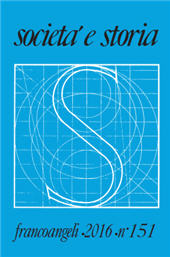Un falso storiografico : la Congregazione del Terrore degli Ufficiali di Roma di Paolo IV.
1-32 p.
L'articolo tratta di un'assise giudiziaria dello Stato della Chiesa, denominata "audientia publica", istituita da Paolo IV il 23 gennaio 1557 e convocata mensilmente fino al luglio 1559. Essa è stata per secoli confusa con una congregazione mai esistita, la Congregazione del Terrore degli Ufficiali di Roma, che pure ha goduto di una fortuna storiografica ricostruita nell'occasione. L'autore delinea quindi il momento istitutivo dell'organo e ne descrive funzione e prassi: nell'udienza pubblica, presieduta dal papa insieme a membri del Sacro Collegio e ai giusdicenti della città di Roma, chiunque si sentisse ingiustamente gravato poteva presentare denunce o ricorsi. Il papa avrebbe avocato a sé la decisione finale o avrebbe delegato ad altri la trattazione del caso. L'analisi dei verbali rimasti ha altresì consentito di enucleare parte dei temi presentati. Ne è scaturita l'immagine di un peculiare strumento di governo della giustizia pontificia a metà cinquecento. [Testo dell'editore]
The article concerns the audientia publica, instituted by pope Paul IV on the 23th of January 1557 and convened on a monthly basis up to July 1559. Until now, it has always been confused with a congregation, the Congregazione del Terrore degli ufficiali di Roma, which never existed although it has attracted considerable historiographical attention. The author begins resolving this misunderstanding, then outlines the institution of this unique court and describes its function and activity: during the audientia publica, presided by the Pope sitting together with members of the Sacred College and Judges from the city Rome, whoever felt unfairly burdened could present complaints or appeals. The pope was himself the final judge or he could delegate to others the handling of the case. The analysis of the Records of the audientia publica (conserved in the Vatican Library) also allows to single out some of the issues presented. The result is a picture of a particular tool for regulating papal justice
in the mid sixteenth century. [Publisher's Text]
Ist Teil von
Società e storia : 151, 1, 2016-
Artikel aus derselben Ausgabe (einzeln erhältlich)
-
-
Informationen
ISSN: 1972-5515



